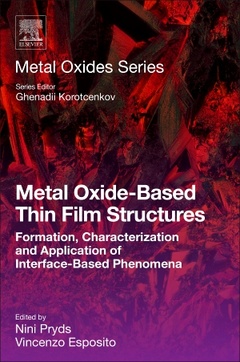Metal Oxide-Based Thin Film Structures Formation, Characterization and Application of Interface-Based Phenomena Metal Oxides Series
Coordonnateurs : Pryds Nini, Esposito Vincenzo

Metal Oxide-Based Thin Film Structures: Formation, Characterization and Application of Interface-Based Phenomena bridges the gap between thin film deposition and device development by exploring the synthesis, properties and applications of thin film interfaces.
Part I deals with theoretical and experimental aspects of epitaxial growth, the structure and morphology of oxide-metal interfaces deposited with different deposition techniques and new developments in growth methods. Part II concerns analysis techniques for the electrical, optical, magnetic and structural properties of thin film interfaces. In Part III, the emphasis is on ionic and electronic transport at the interfaces of Metal-oxide thin films.
Part IV discusses methods for tailoring metal oxide thin film interfaces for specific applications, including microelectronics, communication, optical electronics, catalysis, and energy generation and conservation.
This book is an essential resource for anyone seeking to further their knowledge of metal oxide thin films and interfaces, including scientists and engineers working on electronic devices and energy systems and those engaged in research into electronic materials.
Section A Interface formation: Theoretical aspect in epitaxial growth mechanisms, structural features and defects formation 1. Epitaxy of 5d transition metal oxide thin films and heterostructures 2. Oxide superlattices by PLD: A practical guide 3. Oxide molecular beam epitaxy of complex oxide heterointerfaces 4. Electrochemical ionic interfaces
Section B Experimental: Structural and compositional characterization techniques of metal oxides interfaces 5. In situ stress measurements of metal oxide thin films 6. Plume characterization in pulsed laser deposition of metal oxide thin films 7. Photoemission of buried metal oxide interfaces 8. Functional material properties of oxide thin films probed by atomic force microscopy on the nanoscale 9. Controlled atmosphere high-temperature scanning probe microscopy (CAHT-SPM) 10. Scanning SQUID measurements of oxide interfaces
Section C Modeling and properties at the metal oxide interfaces 11. First-principle study of metal oxide thin films: Electronic and magnetic properties of confined d electrons 12. Computational study of energy materials 13. High-mobility two-dimensional electron gases at complex oxide interfaces 14. Strain and interfaces for metal oxide-based memristive devices
Section D Applications of metal oxide interfaces 15. Metal oxide thin film-based low-temperature-operating solid oxide fuel cell by interface structure control 16. Ionic conductivity of metal oxides: An essential property for all-solid-state lithium-ion batteries 17. Nanoionics and interfaces for energy and information technologies 18. Future emerging technologies based on metal oxide interfaces 19. Ferroelectric and piezoelectric oxide nanostructured films for energy harvesting applications 20. Redox-based memristive metal-oxide devices
Vincenzo Esposito is a Full Professor in “Ceramic Science and Engineering and technology coordinator at the Department of Energy Conversion and Storage, Technical University of Denmark. He developed his career at Risø DTU National Laboratory for Sustainable Energy, University of Rome “Tor Vergata, University of Florida, and at the Instituto de Pesq
- Introduces the theoretical and experimental aspects of epitaxial growth for the benefit of readers new to the field
- Explores state-of-the-art analysis techniques and their application to interface properties in order to give a fuller understanding of the relationship between macroscopic properties and atomic-scale manipulation
- Discusses techniques for tailoring thin film interfaces for specific applications, including information, electronics and energy technologies, making this book essential reading for materials scientists and engineers alike
Date de parution : 09-2017
Ouvrage de 560 p.
15x22.8 cm



